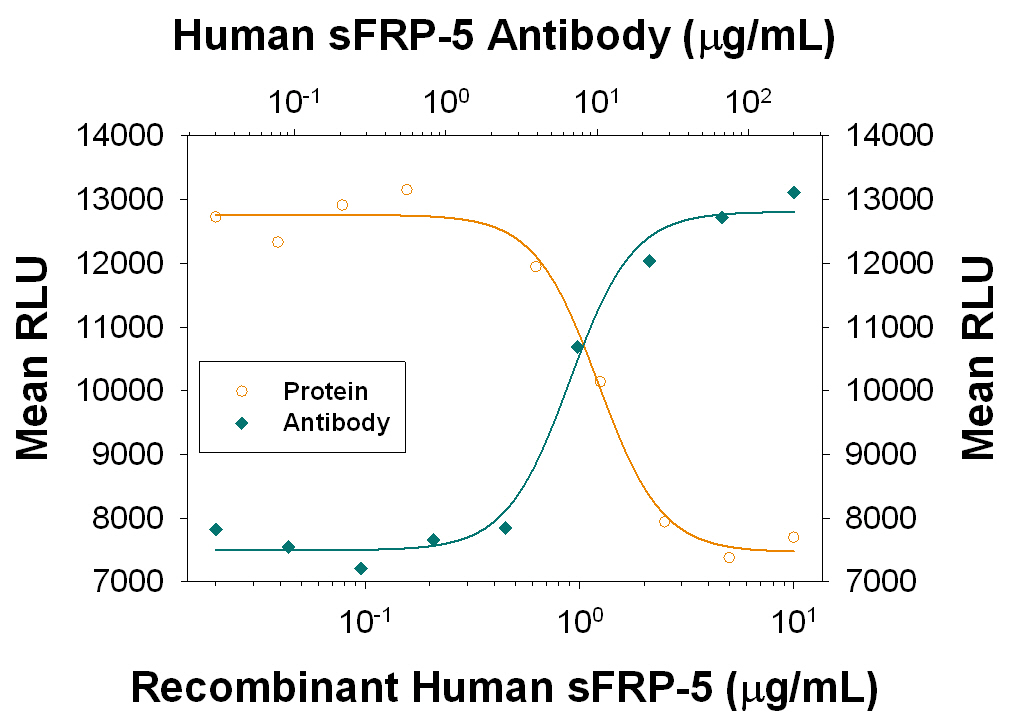Human sFRP-5 Antibody Summary
Glu30-His317
Accession # Q5T4F7
Applications
Please Note: Optimal dilutions should be determined by each laboratory for each application. General Protocols are available in the Technical Information section on our website.
Scientific Data
 View Larger
View Larger
Topflash Reporter Activity Inhibited by sFRP‑5 and Neutralization by Human sFRP‑5 Antibody. Recombinant Human sFRP-5 (Catalog # 6266-SF) inhibits Recombinant Mouse Wnt-3a (Catalog # 1324-WN) induced Topflash reporter activity in the HEK293T human embryonic kidney cell line in a dose-dependent manner (orange line), as measured by the Topflash Reporter Assay. Under these conditions, Topflash reporter activity inhibited by Recombinant Human sFRP-5 (5 µg/mL) is neutralized (blue line) by increasing concentrations of Mouse Anti-Human sFRP-5 Monoclonal Antibody (Catalog # MAB6266) in the presence of 100 ng/mL Recombinant Mouse Wnt-3a. The ND50 is typically 2-10 µg/mL.
Reconstitution Calculator
Preparation and Storage
- 12 months from date of receipt, -20 to -70 °C as supplied.
- 1 month, 2 to 8 °C under sterile conditions after reconstitution.
- 6 months, -20 to -70 °C under sterile conditions after reconstitution.
Background: sFRP-5
Secreted Frizzled Related Protein-5 (sFRP-5), also known as SARP-3, belongs to a family of Wnt‑binding proteins with homology to the ligand‑binding domain of the Frizzled receptors. sFRPs are approximately 30-35 kDa in size and contain an N‑terminal Frizzled-like domain with 10 conserved cysteines and a Netrin-like C-terminal domain (1-3). Mature human sFRP-5 shares 96% aa sequence identity with mouse and rat sFRP-2 (4). During embryonic development, sFRP-5 is expressed in the anterior visceral endoderm, neural tube, foregut epithelium, and proliferating and prehypertrophic chondrocytes (5-8). sFRP-5 activity is required for the development of foregut, liver, ventral pancreas, and somites (6, 7). In the adult, sFRP-5 is expressed in the retinal pigment epithelium and pancreas (4, 9). sFRP-5 binds and antagonizes the function of mammalian Wnt-5a and Wnt-11 as well as Xenopus Xwnt-8, resulting in an inhibition of both canonical and non-canonical Wnt signaling (7, 9, 10). sFRP-5 down-regulation is common in breast and gastric cancer cells and is correlated with poor prognosis (11-13). It functions as a tumor suppressor by inhibiting epithelial-mesenchymal transition, invasiveness, and tumorigenicity of ovarian cancer cells (14). sFRP-5 plays an important role in maintaining glucose handling and insulin sensitivity (10). It is secreted by adipocytes and is down-regulated in mouse models of obesity and type 2 diabetes (10).
- Bovolenta, P. et al. (2008) J. Cell Sci. 121:737.
- van Amerongen, R. and R. Nusse (2009) Development 136:3205.
- Rattner, A. et al. (1997) Proc. Natl. Acad. Sci. 94:2859.
- Melkonyan, H.S. et al. (1997) Proc. Natl. Acad. Sci. 94:13636.
- Leaf, I. et al. (2006) Genesis 44:573.
- Satoh, W. et al. (2008) Genesis 46:92.
- Li, Y. et al. (2008) Genes Dev. 22:3050.
- Witte, F. et al. (2009) Gene Expr. Patterns 9:215.
- Chang, J. et al. (1999) Hum. Mol. Genet. 8:575.
- Ouchi, N. et al. (2010) Science 329:454.
- Veeck, J. et al. (2008) Carcinogenesis 29:991.
- Zhao, C. et al. (2009) BMC Cancer 9:224.
- Ho, C.M. et al. (2010) Eur. J. Clin. Invest. 40:310.
- Su, H.Y. et al. (2010) Int. J. Cancer 127:555.
Product Datasheets
FAQs
No product specific FAQs exist for this product, however you may
View all Antibody FAQsReviews for Human sFRP-5 Antibody
There are currently no reviews for this product. Be the first to review Human sFRP-5 Antibody and earn rewards!
Have you used Human sFRP-5 Antibody?
Submit a review and receive an Amazon gift card.
$25/€18/£15/$25CAN/¥75 Yuan/¥1250 Yen for a review with an image
$10/€7/£6/$10 CAD/¥70 Yuan/¥1110 Yen for a review without an image

